We round up 9 of the best condenser mics for live vocals for when you want studio-quality sound on-stage.
There are a few key options out there when it comes to the best condenser mics for live vocals. Brands like Shure, Neumann, and others offer industry-standard options that are guaranteed to improve your sound when performing live. Plus, they have some added tricks up their sleeves to make sound engineers’ lives easier, thus improving what the crowd hears!
So, we’ve rounded up nine of the best condenser microphones for live vocals from the likes of Shure, Neumann, Sennheiser, and more.
Are condenser microphones good for live use?
Yes, you can use a condenser mic for live vocals. In fact, it can take a great-sounding vocal and turn it into an incredible-sounding one.
They offer a more transparent, detailed sound with a higher output – which is ideal for singers who have a wide range and want the top end of the frequency spectrum to shine through.
Condenser microphones that are specifically designed for live vocal performance have built-in shock mounts (the good ones anyway) that protect the diaphragm and capsule from damage – you’re definitely going to drop your mic at some point.
They almost always have a built-in pop filter or windshield to stop plosives. These are needed as condenser mics are more sensitive to sibilance and plosive noises (the popping sound you get from “P” and “B” sounds when singing).
What’s more, they have cardioid or supercardioid polar patterns to reject any off-axis noise, which could be the musicians around you, the noise from the bar staff, or the crowd. A good condenser mic will only pick up your vocals.
Why switch to a condenser mic?
When you think you may need another sonic option from your SM58 or it’s time to upgrade to something with an extended frequency range, a condenser mic is a great next step.
Singers often switch to a condenser mic because their dynamic mic isn’t providing enough detail in the higher and lower registers of their voice. They might not be getting the output they need and find themselves projecting more than they’re comfortable with.
Condenser microphones allow singers with lower or quieter voices to be heard clearer onstage. They offer the sensitivity required to convey a singer’s emotion – something that a dynamic mic might not always capture.
Vocalists might also use a condenser mic if they want to replicate the studio sound as much as possible onstage.
What to look for
There are three key features to consider in a condenser microphone for live vocals: polar pattern, frequency range, and construction.
Polar pattern
You need a cardioid or supercardioid polar pattern on a condenser mic for live vocals. This is because they pick up every detail of sound directed into the microphone.
If the polar pattern isn’t tight, then you risk the sound of the musicians around you, monitor systems, or the crowd creeping into the microphone, thus muddying your sound. A tight cardioid or supercardioid polar pattern ensures only your voice is heard, and in great detail. For a more in-depth understanding, take a look at our Microphone Polar Patterns blog post.
Frequency range
Frequency range is important to consider when you’re after high levels of detail at all ranges.
If you have a deep voice, you want the microphone to be able to handle it and pick up the sound, retaining the qualities of your voice. The same applies to higher-pitched voices.
A mic with a high-frequency range can pick up the higher registers and detail of your voice without distortion.
Construction
You will drop your microphone at some point – it’s inevitable. As condenser microphones have moving parts, they’re more sensitive to knocks, bumps, and drops and can be damaged if not looked after correctly.
You should look for a condenser microphone with built-in shock mounts to protect the capsule from damage. Fortunately, all mics in this list have a variation of a shock mount.
You also need a condenser mic with a built-in pop filter or windshield to combat plosives and sibilance noises. Condenser mics are very sensitive to these sounds, and in the live arena, you can’t really use an external pop filter. Again, we’ve chosen microphones that have a pop filter built-in.
Show me the 9 best condenser microphones for live vocals!
We’ve picked a variety of industry standards and newcomers.
Let’s dig in!
1. Shure Beta 87A Vocal Microphone
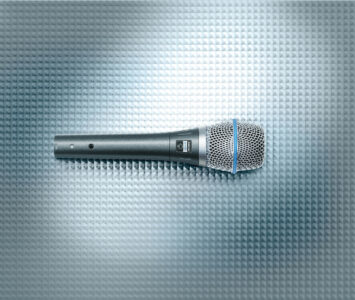 The Shure Beta 87A Vocal Microphone is the industry standard condenser microphone for live vocals under £500.
The Shure Beta 87A Vocal Microphone is the industry standard condenser microphone for live vocals under £500.
At around £260, this microphone is more of an investment than an SM58, but it’s totally worth it if you’re a vocalist in need of higher levels of detail, output, and a smoother bass roll-off that stops unwanted boom from creeping in.
Why is this a good condenser mic for live vocals?
The Shure Beta 87A is one of the best condenser microphones for live vocals thanks to its frequency response of 50Hz – 20kHz. This provides a nice bass roll-off that allows you to get closer to the microphone without the proximity effect kicking in.
If your microphone control isn’t at pro-level – i.e., you don’t move your mic exactly where it needs to be at every single jump in volume, the Shure Beta 87A doesn’t mind.
It also effectively captures all aspects of your mid and high registers without distortion creeping in. Your sound engineer will really appreciate it.
The mic has been designed to bring out your vocals in the mix owing to its boost at the 9kHz mark. This means you don’t have to project your voice as much as you would with a dynamic mic, making it a great option for those with lower-power or quieter voices.
It also has a supercardioid polar pattern, meaning it only picks up the sound of your voice and rejects unwanted off-axis noise. This reduces the chance of feedback from the monitor speakers.
A built-in three-phase pop filter then almost completely eradicates breath and wind noise whilst an advanced shock mount system on the inside of the mic protects the capsule. The shock mount system reduces handling noise too – perfect for fronting a band and playing the guitar or piano. If you’re on a (slightly higher) budget and you’re looking for a vocal mic that provides studio-quality sound on stage, start here.
Shop now | Shure Beta 87A Vocal Microphone
2. Shure KSM9 Cardioid and Supercardioid Condenser Mic
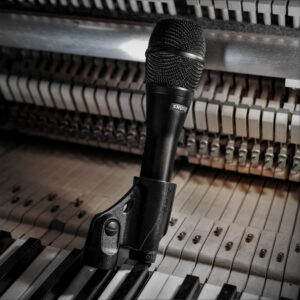 Next up we have the Shure KSM9 Cardioid and Supercardioid Condenser Mic which boosts us into the upper-professional realm in terms of budget and sound quality.
Next up we have the Shure KSM9 Cardioid and Supercardioid Condenser Mic which boosts us into the upper-professional realm in terms of budget and sound quality.
This is a microphone for singers who need absolute perfection and detail in their vocal performance. It’s one of the best condenser mics for live vocals ever made!
Why is this a good condenser mic for live vocals?
The frequency response of 50 Hz – 20 kHz beautifully rolls off unwanted bass frequencies and reduces the chance of the proximity effect ruining a vocal performance.
It boasts an onboard subsonic filter that actually eliminates rumble below 17Hz, so the deepest of voices can be heard in exquisite detail without distortion, feedback, or loss of detail.
Plus, the mic is very forgiving if you forget to move back from it!
The main reason this makes our list is down to the switchable polar pattern. You can switch between cardioid and supercardioid polar patterns in an instant.
But why is this important?
Well, if you feel that your supercardioid polar pattern has reduced the “life” or ambient feel in your performance, you can simply switch it to cardioid and let the mic pick up a little of the room sound.
In cardioid mode, your voice will be slightly less isolated from background noise – perfect for less crowded rooms and small bands. If you’re in a full band, you might prefer the supercardioid pattern as the mic won’t pick up your drummer, guitarist, or other musicians.
Again, you’re safe from knocks and bumps thanks to an advanced suspension shock mount, and the plosives and sibilance won’t make their way into the mix due to the integrated pop filter.
Shop now | Shure KSM9 Cardioid and Supercardioid Condenser Mic
3. Sennheiser e865 Condenser Microphone
 The Sennheiser e865 Condenser Microphone is one of our industry-standard live condenser mics, offering exceptional clarity and feedback-free detail for around £200.
The Sennheiser e865 Condenser Microphone is one of our industry-standard live condenser mics, offering exceptional clarity and feedback-free detail for around £200.
Why is this a good condenser mic for live vocals?
Rugged, hard-wearing, and reliable. The Sennheiser e865 is all these things and more.
Straight out of the box, you’ll benefit from the prograde condenser element.
It’s specifically tuned for live vocal applications.
The high-sensitivity membrane provides a very detailed frequency response of 40Hz – 20kHz which means you’ll get the detail you need at all spectrums, with a slight bass roll-off to combat the proximity effect.
With a supercardioid polar pattern, it provides excellent off-axis rejection, ensuring only your voice is being picked up. This makes it an ideal condenser mic for live vocalists who play with other musicians or in crowded bars, venues, and cafes.
One of the more unique things about this mic is the high SPL of 150dB which allows you to record guitars, snares, and other loud instruments, as well as vocals, in the studio.
The mic is suitable for the tough schedules of touring thanks to a special pop/blast protection plate that reduces plosives and protects the membrane from damage. It’ll stand up to tours for years.
Shop now | Sennheiser e865 Condenser Microphone
4. Neumann KMS 105 Handheld Condenser Vocal Microphone
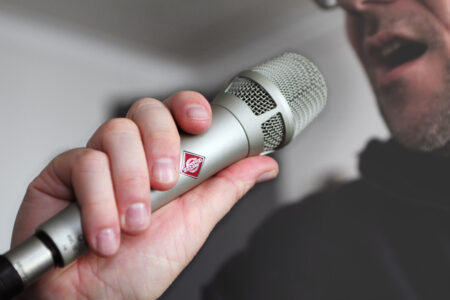 The Neumann KMS 105 Handheld Condenser Vocal Microphone brings studio-quality recording to the stage, offering live vocalists that signature Neumann sound at gigs and live performances.
The Neumann KMS 105 Handheld Condenser Vocal Microphone brings studio-quality recording to the stage, offering live vocalists that signature Neumann sound at gigs and live performances.
Just like Shure, Neumann produces industry-standard microphones for the discerning vocalist. It has the incredibly detailed sonic qualities that professional musicians gravitate towards.
Why is this a good condenser mic for live vocals?
The Neumann KMS 105 is a handheld version of their famed studio microphones, so hopefully that gives you an indication of the quality of sound you can expect.
However, it’s been tuned for live applications and boasts a supercardioid polar pattern which attenuates unwanted sounds from the rear and the sides.
This is also an extremely tough and hard-wearing microphone for live vocalists.
The hardened steel grille keeps your capsule safe whilst the multi-level pop filter – crafted from wire gauze – prevents plosives and unwanted pops from creeping in.
Any sibilance issues are eradicated too by the pop filter, so you’re free to perform however you like. One thing to note is the 20Hz – 20kHz frequency response.
You’ll need some microphone-handling experience as the proximity effect can sometimes creep in if you hold it too close. But if you’re about to drop over £500 for a live vocal microphone, I’ll assume you’ll know what you’re doing!
The extended frequency range means you have less feedback at the extreme lower and higher registers, so you can comfortably record vocals on stage or in the studio.
If you’re a performing musician, you’ll also appreciate the low output impedance of 50 Ohms which means the mic can handle long cable runs of up to 300m without transmission loss. No matter how far away you are from the stage, your voice will sound crystal clear.
Finally, the 150dB SPL means you can record guitar cabs, bass cabs, and snare drums, confident in the knowledge that the capsule can handle it.
Shop now | Neumann KMS 105 Handheld Condenser Vocal Microphone
5. Austrian Audio OC707 True Condenser Vocal Microphone
 The Austrian Audio OC707 True Condenser Vocal Microphone is one of the best condenser mics for live vocals as it provides onboard controls to help singers in less-than-hospitable environments.
The Austrian Audio OC707 True Condenser Vocal Microphone is one of the best condenser mics for live vocals as it provides onboard controls to help singers in less-than-hospitable environments.
Built like a tank, budget-friendly, and with a tuned frequency response – this mic makes life easier onstage.
Why is this a good condenser mic for live vocals?
First off, it has a cardioid polar pattern which provides excellent off-axis rejection whilst maintaining a slight element of room ambience, helping to bring your vocals to life.
One of the key benefits is the onboard high-pass filter which helps to eliminate proximity effects.
If you’re finding that the frequency response of 35Hz – 25kHz is not appropriate for the venue and you’re getting a lot of unwanted boom and bass, just flick the switch and eradicate the unwanted bass frequencies without losing detail.
The rugged die-cast body offers incredible protection for the diaphragm and capsule, ensuring the mic is safe for many years of hard touring and gigging.
An onboard pop filter also helps reduce plosives and unwanted sibilance noises from creeping in, which makes it perfect for rappers, singers, and spoken word artists that want studio-quality vocals on stage.
Lastly, the 150dB SPL means your mic can handle any instrument in the recording studio and the loudest singers on stage.
Shop now | Austrian Audio OC707 True Condenser Vocal Microphone
6. Rode M2 Condenser Microphone
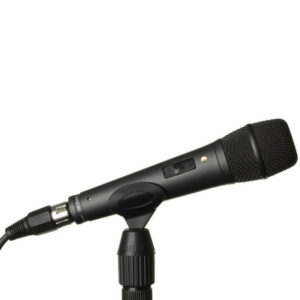 The Rode M2 Condenser Microphone is one of the best budget-friendly condenser mics for live vocals, offering great detail and isolation for vocalists in need of pro-level sound on stage.
The Rode M2 Condenser Microphone is one of the best budget-friendly condenser mics for live vocals, offering great detail and isolation for vocalists in need of pro-level sound on stage.
It’s an industry standard option for those who are on a budget but still need superb quality vocals in a live scenario.
Why is this a good condenser mic for live vocals?
Again, if you’re a vocalist that holds your mic, you’re going to drop it at some point. Fortunately, the team at Rode have considered this and built the M2 microphone with an internal shock-mounted 1/2″ condenser capsule. This protects the microphone from damage when you drop it.
The small, but important, addition of an on/off switch is ideal for rappers, public speakers, and interviewers who need to cut the sound between live performances and songs, allowing for more control onstage.
Additionally, the supercardioid polar pattern and frequency response of 35Hz – 20kHz is extremely impressive considering the price tag is under £100. These provide exceptional off-axis rejection and reduced proximity effect, meaning you can get as close as you need to without feedback or unwanted boom.
This is an affordable option for new singers and venue owners who want quality sound without having to spend a fortune.
Shop now | Rode M2 Condenser Microphone
7. Audio Technica AT2010 Vocal Condenser Microphone
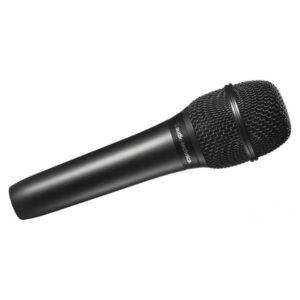 The Audio Technica AT2010 Vocal Condenser Microphone is yet another budget-friendly live condenser mic that gives singers the chance to capture studio-quality vocals on stage.
The Audio Technica AT2010 Vocal Condenser Microphone is yet another budget-friendly live condenser mic that gives singers the chance to capture studio-quality vocals on stage.
It has a detailed frequency response that provides feedback-free recording with a bass-roll off to combat the proximity effect. And it can be used in a home recording studio. For under £100, it’s a great investment.
Why is this a good condenser mic for live vocals?
The AT2010 is equipped with the same high-performance 16mm low-mass diaphragm that can be found in Audio Technica’s revered AT2020 studio condenser microphone. This means you get the same sound quality as a studio mic in the live arena.
The cardioid polar pattern provides crystal-clear audio, free from the interference of surrounding noise, whilst the frequency response of 40Hz – 20kHz promises incredible detail and a bass roll-off to reduce the boom when you’re singing up close.
This microphone has been designed for years of (ab)use. The multi-stage grille design not only provides incredible protection against plosives and sibilance but also protects the capsule from drops and bumps.
The rugged all-metal construction ensures your mic is ready for many years of hard touring. It can be relied on at any given time. The 136dB SPL is also very useful for recording instruments straight to the desk in a live show or at home, making it a great investment for the home studio enthusiast or live engineer.
8. Shure SM86 Condenser Vocal Microphone
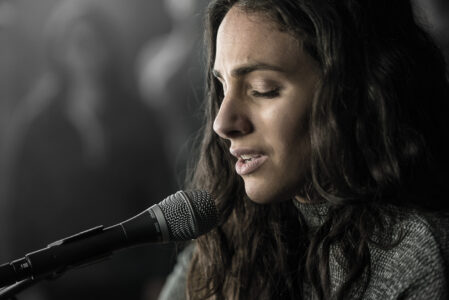 If you’re in love with the SM58 (who isn’t?) but you need some extra detail and “life” in your sound, the Shure SM86 Condenser Vocal Microphone is one of the best live condenser microphones for vocal performances on the market. It’s also very budget-friendly at just over £100.
If you’re in love with the SM58 (who isn’t?) but you need some extra detail and “life” in your sound, the Shure SM86 Condenser Vocal Microphone is one of the best live condenser microphones for vocal performances on the market. It’s also very budget-friendly at just over £100.
Why is this a good condenser mic for live vocals?
This Shure offering has been tailored specifically for live vocals, ensuring they’re heard clearly and accurately. The frequency response of 50Hz – 18kHz removes a lot of the higher and lower frequencies you’ll probably never need – similar to a ribbon microphone. This eliminates unwanted bass boom and higher, feedback-enticing frequencies that can ruin a performance.
On stage, you often don’t need a full frequency response – it can cause mayhem if you have an inexperienced sound engineer or you’re in a room that hasn’t been acoustically treated.
The key feature that live vocalists will love is the grille, which has two miniature pop filters to reduce plosive and sibilance noises. This means you get all the sensitivity of a condenser mic without needing an external pop filter like you would in a studio environment.
Shure’s faultless engineering ensures the microphone is less likely to become damaged after decades of touring. It has a three-point shock mount system that reduces handling noise whilst protecting your capsule. The cardioid polar pattern then rejects the off-axis noise and the max SPL of 147dB means you can record louder instruments or screaming vocals without distortion.
Shop now | Shure SM86 Condenser Vocal Microphone
9. AKG C5 Professional Vocal Condenser Microphone
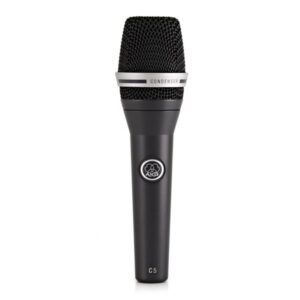 If you front a band or you like placing your lip on the mic when singing, the AKG C5 Professional Vocal Condenser Microphone is a great option.
If you front a band or you like placing your lip on the mic when singing, the AKG C5 Professional Vocal Condenser Microphone is a great option.
Why is this a good condenser mic for live vocals?
The 65 – 20,000Hz frequency response on the AKG C5 is perfect for vocalists in rock and metal bands who, as we all know, like to hold the mic as close to their mouths as possible and shout a lot! The reduced bass response means your mic won’t feed back or create unwanted boom at close range.
The cardioid polar pattern is ideal for in-ear monitoring systems as it provides excellent off-axis rejection, but still retains some “life” and ambience.
Another key benefit is the included PB1000 presence-boosting attachment which can be fastened by removing the grille and screwing it in. This adds a jump in presence to your sound, helping your vocals stand out – again, great for rock and metal bands!
It’s basically two mics for the price of one. If you find your vocals are too loud, simply remove the presence booster and you’re back to the original sound. This makes it ideal for a range of environments!
The rugged grille and solid die-cast housing then ensure your mic lasts decades, even if you drop it from time to time.
Final thoughts
As I always say, it’s best to try as many microphones as you can to find out which option works for you. If you can, stretch your budget where possible and choose industry-standard live vocal condenser mics specifically tuned for the live environment.
Don’t use a recording mic for live vocals – you’ll just have a nightmare onstage. By choosing a condenser microphone designed for live vocals, you’re able to get studio-quality sound on stage. Plus, your sound engineer won’t have to battle the console to get the best sound for you.
But as long as you’re choosing cardioid as a minimum, a hard-wearing option, and a mic with a good frequency response to match your vocal delivery, you’ll be onto a winner!
Post a comment below and let us know if you think we’ve missed any of the best live vocal condenser mics or if you have any tips for performing live with one.

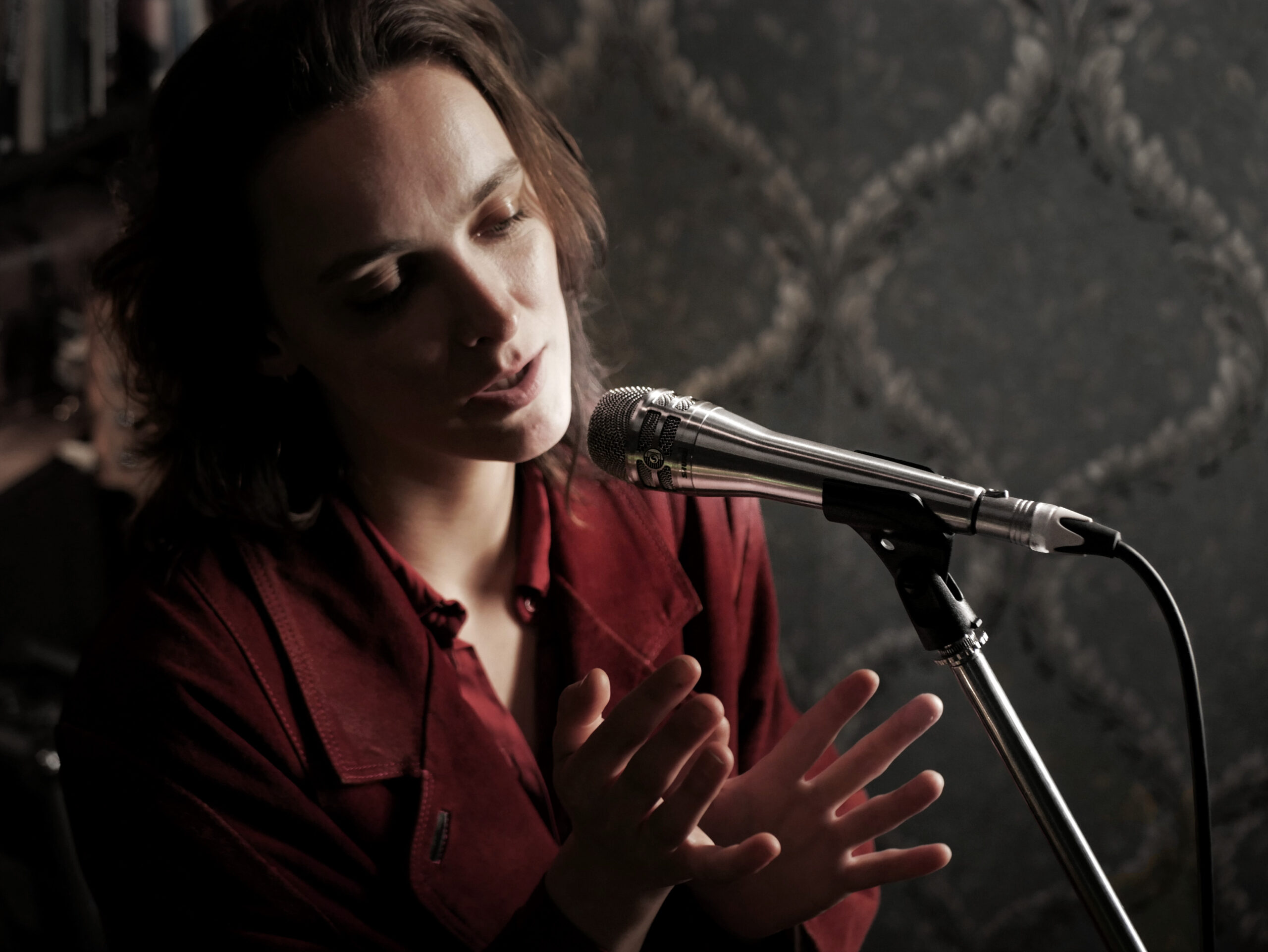












0 Comments